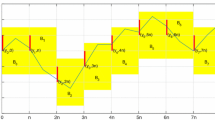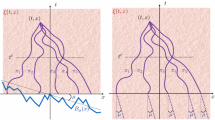Abstract
We study the ergodic theory of stationary directed nearest-neighbor polymer models on \(\mathbb {Z}^2\), with i.i.d. weights. Such models are equivalent to specifying a stationary distribution on the space of weights and correctors that satisfy certain consistency conditions. We show that for a prescribed weight distribution and corrector mean, there is at most one stationary polymer distribution which is ergodic under the \(e_1\) or \(e_2\) shift. Further, if the weights have more than two moments and the corrector mean vector is an extreme point of the superdifferential of the limiting free energy, then the corrector distribution is ergodic under each of the \(e_1\) and \(e_2\) shifts.
Similar content being viewed by others
References
Armstrong, S.N., Souganidis, P.E.: Stochastic homogenization of Hamilton–Jacobi and degenerate Bellman equations in unbounded environments. J. Math. Pures Appl. 97(5), 460–504 (2012)
Balázs, M., Rassoul-Agha, F., Seppäläinen, T.: Large deviations and wandering exponent for random walk in a dynamic beta environment. Ann. Probab. 47(4), 2186–2229 (2019)
Barraquand, G., Corwin, I.: Random-walk in Beta-distributed random environment. Probab. Theory Relat. Fields 167(3–4), 1057–1116 (2017)
Chang, C.S.: On the input-output map of a \(G/G/1\) queue. J. Appl. Probab. 31(4), 1128–1133 (1994)
Chaumont, H., Noack, C.: Characterizing stationary \(1+1\) dimensional lattice polymer models. Electron. J. Probab. 23, 19 (2018)
Chaumont, H., Noack, C.: Fluctuation exponents for stationary exactly solvable lattice polymer models via a Mellin transform framework. ALEA Lat. Am. J. Probab. Math. Stat. 15(1), 509–547 (2018)
Comets, F.: Directed Polymers in Random Environments. Lecture Notes in Mathematics, vol. 2175. Springer, Cham (2017)
Comets, F., Shiga, T., Yoshida, N.: Probabilistic analysis of directed polymers in a random environment: a review. In: Stochastic analysis on large scale interacting systems, Adv. Stud. Pure Math., vol. 39, pp. 115–142. Math. Soc. Japan, Tokyo (2004)
Corwin, I.: The Kardar–Parisi–Zhang equation and universality class. Random Matrices Theory Appl. 1(1), 1130,001, 76 (2012)
Corwin, I.: Kardar-Parisi-Zhang Universality. Notices Am. Math. Soc. 63(3), 230–239 (2016)
Corwin, I., Seppäläinen, T., Shen, H.: The strict-weak lattice polymer. J. Stat. Phys. 160(4), 1027–1053 (2015)
Georgiou, N., Rassoul-Agha, F., Seppäläinen, T., Yilmaz, A.: Ratios of partition functions for the log-gamma polymer. Ann. Probab. 43(5), 2282–2331 (2015)
Giacomin, G.: Random polymer models. Imperial College Press, London (2007)
Gray, R.M.: Probability, random processes, and ergodic properties, 2nd edn. Springer, Dordrecht (2009)
Halpin-Healy, T., Takeuchi, K.A.: A KPZ cocktail—shaken, not stirred...toasting 30 years of kinetically roughened surfaces. J. Stat. Phys. 160(4), 794–814 (2015)
den Hollander, F.: Random Polymers. Lecture Notes in Mathematics, vol. 1974. Springer, Berlin (2009)
Huse, D.A., Henley, C.L.: Pinning and roughening of domain walls in ising systems due to random impurities. Phys. Rev. Lett. 54(25), 2708–2711 (1985)
Janjigian, C., Rassoul-Agha, F.: Busemann functions and Gibbs measures in directed polymer models on \(\mathbb{Z}^2\). (2018). Extended version (arXiv:1810.03580v2)
Janjigian, C., Rassoul-Agha, F.: Busemann functions and Gibbs measures in directed polymer models on \(\mathbb{Z}^2\). Ann. Probab. (2019). https://doi.org/10.1214/19-AOP1375
Janjigian, C., Rassoul-Agha, F.: Existence, uniqueness, and stability of global solutions of a discrete stochastic Burgers equation. (2019). Preprint
Janjigian, C., Rassoul-Agha, F., Seppäläinen, T.: Geometry of geodesics through Busemann measures in directed last-passage percolation (2019). Preprint (arXiv:1908.09040)
Kardar, M., Parisi, G., Zhang, Y.C.: Dynamic scaling of growing interfaces. Phys. Rev. Lett. 56, 889–892 (1986)
Kosygina, E.: Homogenization of stochastic Hamilton-Jacobi equations: brief review of methods and applications. In: Stochastic and Partial Differential Equations, Contemporary Mathematics, vol. 429, pp. 189–204. American Mathematical Society, Providence, RI (2007)
Krug, J., Meakin, P., Halpin-Healy, T.: Amplitude universality for driven interfaces and directed polymers in random media. Phys. Rev. A 45, 638–653 (1992)
O’Connell, N., Yor, M.: Brownian analogues of Burke’s theorem. Stoch. Process. Appl. 96(2), 285–304 (2001)
Quastel, J.: Introduction to KPZ. Current Developments in Mathematics, pp. 125–194. International Press, Somerville, MA (2011)
Quastel, J., Spohn, H.: The one-dimensional KPZ equation and its universality class. J. Stat. Phys. 160(4), 965–984 (2015)
Rassoul-Agha, F., Seppäläinen, T.: Quenched point-to-point free energy for random walks in random potentials. Probab. Theory Relat. Fields 158(3–4), 711–750 (2014)
Seppäläinen, T.: Scaling for a one-dimensional directed polymer with boundary conditions. Ann. Probab. 40(1), 19–73 (2012). Corrected version available at arXiv:0911.2446
Spohn, H.: KPZ scaling theory and the semidiscrete directed polymer model. In: Random matrix theory, interacting particle systems, and integrable systems, Math. Sci. Res. Inst. Publ., vol. 65, pp. 483–493. Cambridge University Press, New York (2014)
Thiery, T.: Stationary measures for two dual families of finite and zero temperature models of directed polymers on the square lattice. J. Stat. Phys. 165(1), 44–85 (2016)
Thiery, T., Le Doussal, P.: On integrable directed polymer models on the square lattice. J. Phys. A 48(46), 465,001, 41 (2015)
Acknowledgements
C. Janjigian was partially supported by a postdoctoral grant from the Fondation Sciences Mathématiques de Paris while working at Université Paris Diderot. F. Rassoul-Agha was partially supported by National Science Foundation grants DMS-1407574 and DMS-1811090.
Author information
Authors and Affiliations
Corresponding author
Additional information
Communicated by Eric A. Carlen.
Publisher's Note
Springer Nature remains neutral with regard to jurisdictional claims in published maps and institutional affiliations.
Rights and permissions
About this article
Cite this article
Janjigian, C., Rassoul-Agha, F. Uniqueness and Ergodicity of Stationary Directed Polymers on \(\mathbb {Z}^2\). J Stat Phys 179, 672–689 (2020). https://doi.org/10.1007/s10955-020-02541-z
Received:
Accepted:
Published:
Issue Date:
DOI: https://doi.org/10.1007/s10955-020-02541-z




